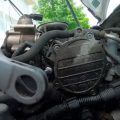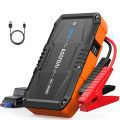This guide provides a straightforward, step-by-step process for performing a smog check using an OBD2 scanner, which is an essential tool for DIY mechanics. It explains how to connect the scanner to your vehicle, retrieve diagnostic trouble codes, and interpret the emissions data to assess whether your vehicle meets the required standards for passing a smog test. By following this guide, you can effectively evaluate your vehicle’s emissions status and take necessary actions to ensure compliance with environmental regulations.



Gather Your Tools
Gather an OBD2 scanner, which is essential for diagnosing and troubleshooting vehicle issues. Ensure your vehicle is equipped with an OBD2 port, typically located under the dashboard near the steering column. Check your vehicle’s manual or do a quick online search if you’re unsure about its location. Equip yourself with safety gear, such as gloves and safety goggles, to protect yourself during the inspection process.
Familiarize yourself with the scanner’s manual to understand its specific functions and features. Read through the sections detailing how to connect the scanner to the OBD2 port, as well as how to interpret the codes it generates. For example, learn how to retrieve diagnostic trouble codes (DTCs) and understand what they signify about your vehicle’s performance. Knowing these details will empower you to effectively use the scanner and address any issues that arise.
Locate the OBD2 Port
Locate the OBD2 port under the dashboard near the steering column. Follow these steps:
- Position yourself in the driver’s seat for easy access.
- Look beneath the dashboard, just to the left of the steering wheel.
- If necessary, adjust your seating position for better visibility.
- Search for a connector that resembles a trapezoid shape with 16 pins.
- Ensure that your vehicle is turned off before proceeding with any further actions.
- If needed, use a flashlight to illuminate dark areas for easier identification.
Identify the OBD2 port and familiarize yourself with its location, as this will be essential for connecting diagnostic tools or scanners in the future.
Connect the OBD2 Scanner
Plug the OBD2 scanner into the vehicle’s OBD2 port, which is usually located under the dashboard near the driver’s seat. Ensure the connection is secure; a loose connection may prevent the scanner from communicating properly with the vehicle’s onboard computer.
Turn the ignition key to the ‘on’ position without starting the engine. This step powers the OBD2 scanner and allows it to establish a connection with your vehicle’s systems. Look for dashboard lights to illuminate, indicating that the vehicle’s electrical systems are active. You may hear the scanner power up, and it should display a welcome message or prompt you to begin scanning for diagnostic trouble codes (DTCs).
Select Emissions Readings
Access the scanner’s interface and locate the menu option labeled “Emissions” or “Readiness.” Navigate through the options using the directional keys or touchscreen prompts until you find the section that displays emissions data. Once in this section, review the information regarding various monitors related to emissions control, such as the Oxygen Sensor Monitor, Catalyst Monitor, or Evaporative System Monitor. Each monitor will indicate whether it is “Ready” or “Not Ready,” which signifies whether the specific emissions system is functioning properly.
Observe the readiness status closely. For example, if the Oxygen Sensor Monitor shows “Ready,” it indicates that the vehicle’s oxygen sensors are operating optimally and have completed their diagnostic tests. Conversely, if the Evaporative System Monitor displays “Not Ready,” this may suggest that the system has not completed its self-check, which could be due to recent repairs or a long period of inactivity. Make note of these statuses, as they provide crucial insights into the vehicle’s emissions health and readiness for inspection.
Read Diagnostic Trouble Codes (DTCs)
Check for any stored or pending Diagnostic Trouble Codes (DTCs) using an OBD-II scanner. Follow these steps for effective diagnostics:
- Connect the OBD-II scanner to your vehicle’s diagnostic port, typically located under the dashboard near the driver’s seat.
- Turn the ignition key to the “On” position without starting the engine.
- Navigate to the “Read Codes” option on the scanner’s menu. This will pull up any DTCs that the vehicle’s computer has logged.
Take note of any codes displayed. These codes may indicate issues with your vehicle’s emissions system. For example:
- P0420: Catalyst System Efficiency Below Threshold (Bank 1) – This code suggests that the catalytic converter may not be working efficiently, potentially leading to increased emissions.
- P0455: Evaporative Emission Control System Leak Detected (Large Leak) – This indicates a significant leak in the evaporative system that could affect fuel vapor containment.
Reference the scanner’s manual for detailed explanations of the codes retrieved. This will help you understand the specific issues your vehicle may be facing. Document the codes for future reference or when seeking professional assistance.
Clear Codes and Recheck
Clear the trouble codes from your vehicle’s onboard diagnostic system using an OBD-II scanner. Connect the scanner to the diagnostic port, typically located under the dashboard near the steering column. Follow the prompts on the scanner to access the trouble codes and select the option to clear them. This action will reset the system and may help in resolving minor issues that could affect emissions.
Recheck the emissions status after clearing the codes. Start the vehicle and allow it to reach normal operating temperature, as this ensures that all systems are functioning properly. Drive the vehicle for a short distance to allow the onboard computer to run diagnostic tests. After a few miles, use the OBD-II scanner again to check for any reoccurring codes and verify the emissions status. Ensure that the vehicle is in good working condition, including checking fluid levels, tire pressure, and any visible signs of wear before this final check. For example, if you find the check engine light is off and no new codes appear, it indicates that the vehicle is ready for emissions testing.
Final Thoughts and Tips
In conclusion, performing a smog check with an OBD2 scanner is a straightforward process that empowers vehicle owners to monitor their emissions effectively. By adhering to the outlined steps, you not only ensure your vehicle remains compliant with regulations but also contribute to a healthier environment. Regular emissions checks are a proactive approach to vehicle maintenance and sustainability, ultimately benefiting both you and the planet.







Great guide! I just got a BlueDriver OBD2 scanner and it worked like a charm. If you’re a DIY mechanic, I highly recommend it. It’s super user-friendly and gives you detailed emissions data which really helped me understand my car’s issues better. Just remember to check the compatibility with your vehicle before buying!
I ran into some issues when trying to connect my scanner; it just wouldn’t sync with my car. I checked the port and it looked fine, but I’m still getting an error message. Anyone have tips on troubleshooting this? It’s a 2011 Honda Civic.
Sorry to hear you’re having trouble! A common issue could be the vehicle’s ignition not being in the ‘On’ position, or a blown fuse. Double-check those, and if it’s still not working, try a different scanner if you have access to one.
One tip I’d like to add is to always update your OBD2 scanner’s firmware! I made the mistake of not doing that and it led to some weird readings. Once I updated, everything worked perfectly. Just a little maintenance goes a long way!
Great suggestion! Keeping the firmware updated can really enhance the performance of your scanner. Thanks for sharing your insight!
Thanks for the tip! The BlueDriver is indeed a popular choice among DIYers. It’s great to hear that it worked well for you. Happy scanning!
I adapted the guide a bit! Instead of just clearing the DTCs, I took the time to look up each code first. Some were related to minor issues I could fix myself, like a loose gas cap. It really helped me avoid unnecessary repairs down the line!
That’s a smart approach! Understanding the codes before clearing them can definitely save you a lot of hassle. Thanks for sharing your variation!
I followed this guide step by step and had success! My car passed the smog check after I cleared some old codes. I was a bit nervous at first, but everything went smoothly. Make sure you double-check your connections at the OBD2 port, as mine was a bit loose at first.
Awesome to hear that you had success! Those connections can be tricky sometimes. Thanks for sharing your experience!